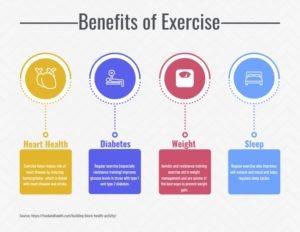Building Blocks of Health: Exercise
We’ve been talking about the various building blocks of health including whole grains, fruits, vegetables, and lean, high-quality protein. In addition to a healthful, balanced diet, regular movement is vital to health promotion and disease prevention.It’s not just a matter of taking a walk. That’s a great place to start, but your body craves a little bit more attention. Lettuce starts with types of exercise.AerobicBack in the day, Jane Fonda was the queen of aerobic exercise. Headbands and leg warmers were all the rage. Aerobic exercise is also known as cardiorespiratory exercise or simply “cardio”. During aerobic exercise, your body is using more oxygen which increases heart rate and pumps oxygen to all the tissues of your body.Aerobic exercise includes walking, biking, jogging, rowing, hiking, dancing, and gardening, to name a few. More intense aerobic exercise may include running, playing tennis, jumping rope, or swimming laps.The American Heart Association advises a minimum of 150 minutes of aerobic exercise each week or roughly 5, 30-minute bouts per week. Ideally, cardio exercise should be sustained for at least 20 minutes and the intensity may vary. You should be able to carry a conversation during aerobic exercise, but will be a bit winded. 1Strength trainingStrength training is also known as resistance training and is meant to build muscle. While most people think of weight lifting as strength training, other methods can improve strength such as nautilus machines or using your own weight to create resistance (such as doing a plank) or “sitting on a wall”.Strength training should be done at least twice per week for 20 to 30 minutes. This can be done at home using free weights, a medicine ball, resistance bands, or your own weight. It may also be performed at a gym or other fitness center. 1StretchingDon’t just think of yoga when you think of stretching. Yes, yoga is lovely, but stretching is important to improve balance and flexibility and stretch your muscles. Stretching warms your muscles up for a workout and helps cool them down at the end.Stretching should be done in 3- to 5-minute bouts and is beneficial after endurance exercises such as a long run or bike ride. Stretch slowly and smoothly and not in a bouncy or jerky motion. Stretching can be a great stress reliever and break from a sedentary job. 1Why exercise?The benefits of exercise far outweigh being a couch potato. For starters, exercise helps reduce the risk of heart disease by reducing homocysteine- a byproduct of protein metabolism that when elevated, is linked with heart disease and stroke. 2Regular exercise (especially resistance training) improves glucose levels in those with type 1 and type 2 diabetes. 3Aerobic and resistance training exercise also aids in weight management and is one of the best ways to prevent weight gain as we age. Muscle is more metabolic at rest, so the more you have, the better your body handles calories. 4Regular exercise also improves self-esteem and mood and helps regulate sleep cycles. The bottom line is that Nike ad -- JUST DO IT. 5Below are some simple tips to help get moving:
- Add it to your schedule. Scheduled exercise is an exercise that gets DONE.
- Set an alarm to get up and stretch or walk for at least 5 minutes for every 60 minutes you’re sitting. Research shows that sedentary behavior is one of the biggest risk factors for heart disease.
- Invest in a few hand weights and look up a few exercises on youtube.com or other fitness channels.
- Walk for 15 minutes after lunch or dinner each day. This aids in digestion and also lowers post-prandial blood sugar.
- Find a friend. Ask a neighbor, relative, friend, or co-worker to join you in a fitness class. Accountability may keep you motivated (and fitness is more fun with a friend).
And here's a handout with some highlights from today's post! By Lisa Andrews, MEd, RD, LDReferences:
By Lisa Andrews, MEd, RD, LDReferences:
- American Heart Association Recommendations for Physical Activity in Adults and Kids | American Heart Association
- Chernyavskiy I, Veeranki S, Sen U, Tyagi SC. Atherogenesis: hyperhomocysteinemia interactions with LDL, macrophage function, paraoxonase 1, and exercise. Ann N Y Acad Sci. 2016 Jan;1363(1):138-54
- Pan B, Ge L, Xun YQ, Chen YJ, Gao CY, Han X, Zuo LQ, Shan HQ, Yang KH, Ding GW, Tian JH. Exercise training modalities in patients with type 2 diabetes mellitus: a systematic review and network meta-analysis. Int J Behav Nutr Phys Act. 2018 Jul 25;15(1):72.
- Reddy R, Wittenberg A, Castle JR, El Youssef J, Winters-Stone K, Gillingham M, Jacobs PG. Effect of Aerobic and Resistance Exercise on Glycemic Control in Adults With Type 1 Diabetes. Can J Diabetes. 2019 Aug;43(6):406-414
- Villareal DT, Aguirre L, Gurney AB, Waters DL, Sinacore DR, Colombo E, Armamento-Villareal R, Qualls C. Aerobic or Resistance Exercise, or Both, in Dieting Obese Older Adults. N Engl J Med. 2017 May 18;376(20):1943-1955.
- Archer T, Josefsson T, Lindwall M. Effects of physical exercise on depressive symptoms and biomarkers in depression. CNS Neurol Disord Drug Targets. 2014;13(10):1640-53
- Lavie CJ, Ozemek C, Carbone S, Katzmarzyk PT, Blair SN. Sedentary Behavior, Exercise, and Cardiovascular Health. Circ Res. 2019 Mar;124(5):799-815


